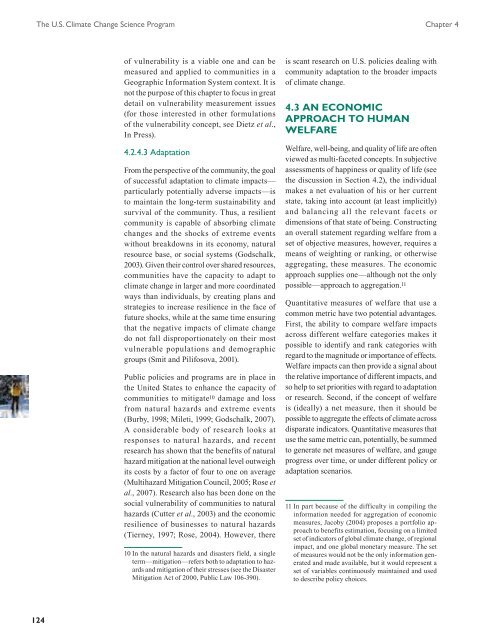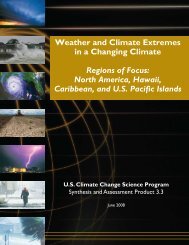Analyses of the Effects of Global Change on - US Climate Change ...
Analyses of the Effects of Global Change on - US Climate Change ...
Analyses of the Effects of Global Change on - US Climate Change ...
You also want an ePaper? Increase the reach of your titles
YUMPU automatically turns print PDFs into web optimized ePapers that Google loves.
The U.S. <strong>Climate</strong> <str<strong>on</strong>g>Change</str<strong>on</strong>g> Science Program Chapter 4<br />
124<br />
<str<strong>on</strong>g>of</str<strong>on</strong>g> vulnerability is a viable <strong>on</strong>e and can be<br />
measured and applied to communities in a<br />
Geographic Informati<strong>on</strong> System c<strong>on</strong>text. It is<br />
not <str<strong>on</strong>g>the</str<strong>on</strong>g> purpose <str<strong>on</strong>g>of</str<strong>on</strong>g> this chapter to focus in great<br />
detail <strong>on</strong> vulnerability measurement issues<br />
(for those interested in o<str<strong>on</strong>g>the</str<strong>on</strong>g>r formulati<strong>on</strong>s<br />
<str<strong>on</strong>g>of</str<strong>on</strong>g> <str<strong>on</strong>g>the</str<strong>on</strong>g> vulnerability c<strong>on</strong>cept, see Dietz et al.,<br />
In Press).<br />
4.2.4.3 Adaptati<strong>on</strong><br />
From <str<strong>on</strong>g>the</str<strong>on</strong>g> perspective <str<strong>on</strong>g>of</str<strong>on</strong>g> <str<strong>on</strong>g>the</str<strong>on</strong>g> community, <str<strong>on</strong>g>the</str<strong>on</strong>g> goal<br />
<str<strong>on</strong>g>of</str<strong>on</strong>g> successful adaptati<strong>on</strong> to climate impacts—<br />
particularly potentially adverse impacts—is<br />
to maintain <str<strong>on</strong>g>the</str<strong>on</strong>g> l<strong>on</strong>g-term sustainability and<br />
survival <str<strong>on</strong>g>of</str<strong>on</strong>g> <str<strong>on</strong>g>the</str<strong>on</strong>g> community. Thus, a resilient<br />
community is capable <str<strong>on</strong>g>of</str<strong>on</strong>g> absorbing climate<br />
changes and <str<strong>on</strong>g>the</str<strong>on</strong>g> shocks <str<strong>on</strong>g>of</str<strong>on</strong>g> extreme events<br />
without breakdowns in its ec<strong>on</strong>omy, natural<br />
resource base, or social systems (Godschalk,<br />
2003). Given <str<strong>on</strong>g>the</str<strong>on</strong>g>ir c<strong>on</strong>trol over shared resources,<br />
communities have <str<strong>on</strong>g>the</str<strong>on</strong>g> capacity to adapt to<br />
climate change in larger and more coordinated<br />
ways than individuals, by creating plans and<br />
strategies to increase resilience in <str<strong>on</strong>g>the</str<strong>on</strong>g> face <str<strong>on</strong>g>of</str<strong>on</strong>g><br />
future shocks, while at <str<strong>on</strong>g>the</str<strong>on</strong>g> same time ensuring<br />
that <str<strong>on</strong>g>the</str<strong>on</strong>g> negative impacts <str<strong>on</strong>g>of</str<strong>on</strong>g> climate change<br />
do not fall disproporti<strong>on</strong>ately <strong>on</strong> <str<strong>on</strong>g>the</str<strong>on</strong>g>ir most<br />
vulnerable populati<strong>on</strong>s and demographic<br />
groups (Smit and Pilifosova, 2001).<br />
Public policies and programs are in place in<br />
<str<strong>on</strong>g>the</str<strong>on</strong>g> United States to enhance <str<strong>on</strong>g>the</str<strong>on</strong>g> capacity <str<strong>on</strong>g>of</str<strong>on</strong>g><br />
communities to mitigate 10 damage and loss<br />
from natural hazards and extreme events<br />
(Burby, 1998; Mileti, 1999; Godschalk, 2007).<br />
A c<strong>on</strong>siderable body <str<strong>on</strong>g>of</str<strong>on</strong>g> research looks at<br />
resp<strong>on</strong>ses to natural hazards, and recent<br />
research has shown that <str<strong>on</strong>g>the</str<strong>on</strong>g> benefits <str<strong>on</strong>g>of</str<strong>on</strong>g> natural<br />
hazard mitigati<strong>on</strong> at <str<strong>on</strong>g>the</str<strong>on</strong>g> nati<strong>on</strong>al level outweigh<br />
its costs by a factor <str<strong>on</strong>g>of</str<strong>on</strong>g> four to <strong>on</strong>e <strong>on</strong> average<br />
(Multihazard Mitigati<strong>on</strong> Council, 2005; Rose et<br />
al., 2007). Research also has been d<strong>on</strong>e <strong>on</strong> <str<strong>on</strong>g>the</str<strong>on</strong>g><br />
social vulnerability <str<strong>on</strong>g>of</str<strong>on</strong>g> communities to natural<br />
hazards (Cutter et al., 2003) and <str<strong>on</strong>g>the</str<strong>on</strong>g> ec<strong>on</strong>omic<br />
resilience <str<strong>on</strong>g>of</str<strong>on</strong>g> businesses to natural hazards<br />
(Tierney, 1997; Rose, 2004). However, <str<strong>on</strong>g>the</str<strong>on</strong>g>re<br />
10 In <str<strong>on</strong>g>the</str<strong>on</strong>g> natural hazards and disasters field, a single<br />
term—mitigati<strong>on</strong>—refers both to adaptati<strong>on</strong> to hazards<br />
and mitigati<strong>on</strong> <str<strong>on</strong>g>of</str<strong>on</strong>g> <str<strong>on</strong>g>the</str<strong>on</strong>g>ir stresses (see <str<strong>on</strong>g>the</str<strong>on</strong>g> Disaster<br />
Mitigati<strong>on</strong> Act <str<strong>on</strong>g>of</str<strong>on</strong>g> 2000, Public Law 106-390).<br />
is scant research <strong>on</strong> U.S. policies dealing with<br />
community adaptati<strong>on</strong> to <str<strong>on</strong>g>the</str<strong>on</strong>g> broader impacts<br />
<str<strong>on</strong>g>of</str<strong>on</strong>g> climate change.<br />
4.3 AN ECONOMIC<br />
APPROACH TO HUMAN<br />
WELFARE<br />
Welfare, well-being, and quality <str<strong>on</strong>g>of</str<strong>on</strong>g> life are <str<strong>on</strong>g>of</str<strong>on</strong>g>ten<br />
viewed as multi-faceted c<strong>on</strong>cepts. In subjective<br />
assessments <str<strong>on</strong>g>of</str<strong>on</strong>g> happiness or quality <str<strong>on</strong>g>of</str<strong>on</strong>g> life (see<br />
<str<strong>on</strong>g>the</str<strong>on</strong>g> discussi<strong>on</strong> in Secti<strong>on</strong> 4.2), <str<strong>on</strong>g>the</str<strong>on</strong>g> individual<br />
makes a net evaluati<strong>on</strong> <str<strong>on</strong>g>of</str<strong>on</strong>g> his or her current<br />
state, taking into account (at least implicitly)<br />
and balancing all <str<strong>on</strong>g>the</str<strong>on</strong>g> relevant facets or<br />
dimensi<strong>on</strong>s <str<strong>on</strong>g>of</str<strong>on</strong>g> that state <str<strong>on</strong>g>of</str<strong>on</strong>g> being. C<strong>on</strong>structing<br />
an overall statement regarding welfare from a<br />
set <str<strong>on</strong>g>of</str<strong>on</strong>g> objective measures, however, requires a<br />
means <str<strong>on</strong>g>of</str<strong>on</strong>g> weighting or ranking, or o<str<strong>on</strong>g>the</str<strong>on</strong>g>rwise<br />
aggregating, <str<strong>on</strong>g>the</str<strong>on</strong>g>se measures. The ec<strong>on</strong>omic<br />
approach supplies <strong>on</strong>e—although not <str<strong>on</strong>g>the</str<strong>on</strong>g> <strong>on</strong>ly<br />
possible—approach to aggregati<strong>on</strong>. 11<br />
Quantitative measures <str<strong>on</strong>g>of</str<strong>on</strong>g> welfare that use a<br />
comm<strong>on</strong> metric have two potential advantages.<br />
First, <str<strong>on</strong>g>the</str<strong>on</strong>g> ability to compare welfare impacts<br />
across different welfare categories makes it<br />
possible to identify and rank categories with<br />
regard to <str<strong>on</strong>g>the</str<strong>on</strong>g> magnitude or importance <str<strong>on</strong>g>of</str<strong>on</strong>g> effects.<br />
Welfare impacts can <str<strong>on</strong>g>the</str<strong>on</strong>g>n provide a signal about<br />
<str<strong>on</strong>g>the</str<strong>on</strong>g> relative importance <str<strong>on</strong>g>of</str<strong>on</strong>g> different impacts, and<br />
so help to set priorities with regard to adaptati<strong>on</strong><br />
or research. Sec<strong>on</strong>d, if <str<strong>on</strong>g>the</str<strong>on</strong>g> c<strong>on</strong>cept <str<strong>on</strong>g>of</str<strong>on</strong>g> welfare<br />
is (ideally) a net measure, <str<strong>on</strong>g>the</str<strong>on</strong>g>n it should be<br />
possible to aggregate <str<strong>on</strong>g>the</str<strong>on</strong>g> effects <str<strong>on</strong>g>of</str<strong>on</strong>g> climate across<br />
disparate indicators. Quantitative measures that<br />
use <str<strong>on</strong>g>the</str<strong>on</strong>g> same metric can, potentially, be summed<br />
to generate net measures <str<strong>on</strong>g>of</str<strong>on</strong>g> welfare, and gauge<br />
progress over time, or under different policy or<br />
adaptati<strong>on</strong> scenarios.<br />
11 In part because <str<strong>on</strong>g>of</str<strong>on</strong>g> <str<strong>on</strong>g>the</str<strong>on</strong>g> difficulty in compiling <str<strong>on</strong>g>the</str<strong>on</strong>g><br />
informati<strong>on</strong> needed for aggregati<strong>on</strong> <str<strong>on</strong>g>of</str<strong>on</strong>g> ec<strong>on</strong>omic<br />
measures, Jacoby (2004) proposes a portfolio approach<br />
to benefits estimati<strong>on</strong>, focusing <strong>on</strong> a limited<br />
set <str<strong>on</strong>g>of</str<strong>on</strong>g> indicators <str<strong>on</strong>g>of</str<strong>on</strong>g> global climate change, <str<strong>on</strong>g>of</str<strong>on</strong>g> regi<strong>on</strong>al<br />
impact, and <strong>on</strong>e global m<strong>on</strong>etary measure. The set<br />
<str<strong>on</strong>g>of</str<strong>on</strong>g> measures would not be <str<strong>on</strong>g>the</str<strong>on</strong>g> <strong>on</strong>ly informati<strong>on</strong> generated<br />
and made available, but it would represent a<br />
set <str<strong>on</strong>g>of</str<strong>on</strong>g> variables c<strong>on</strong>tinuously maintained and used<br />
to describe policy choices.




